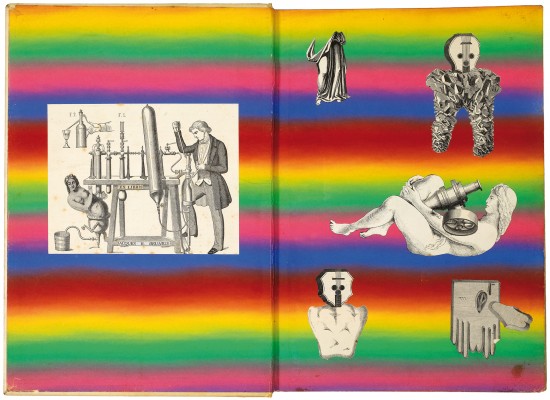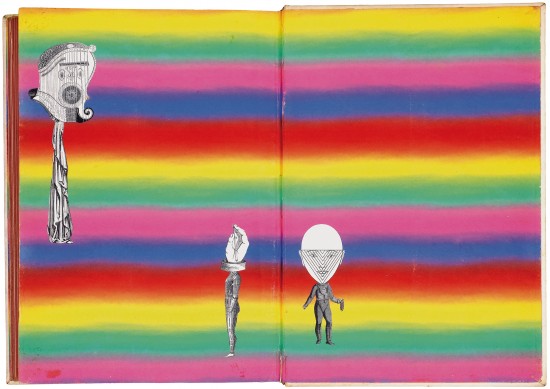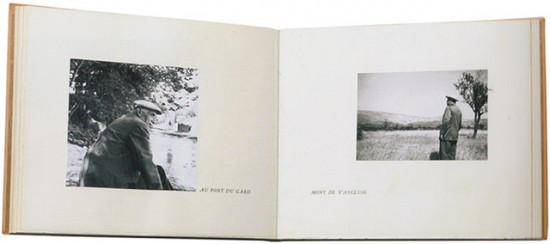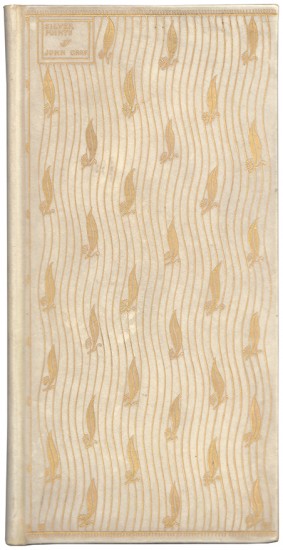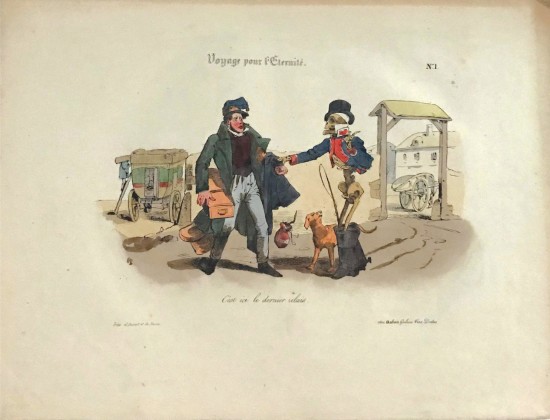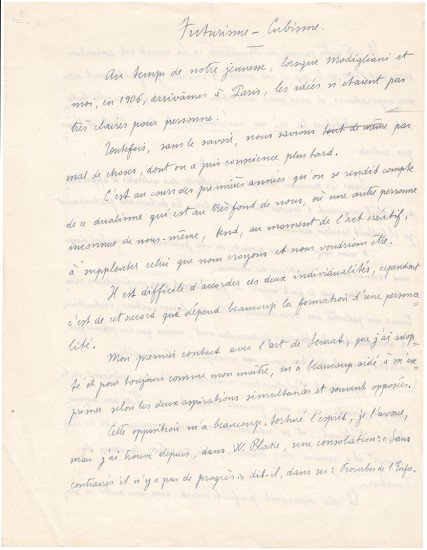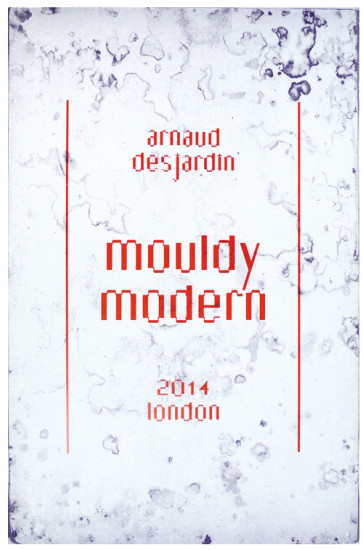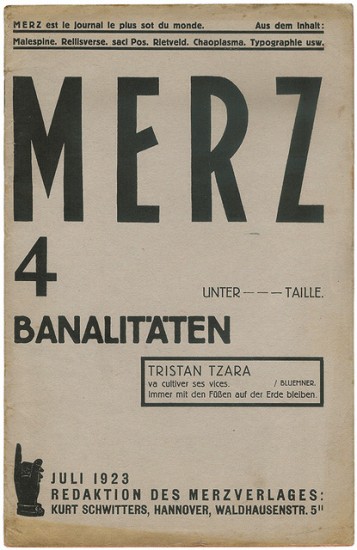REVOLUTION SURREALISTE, LA. Première Année No. 1 (1er Décembre 1924) -Cinquième Année No. 12 (15 Décembre 1929). [All Published]
Revolution Surrealiste
Paris. Directeurs: Pierre Naville et Benjamin Péret. 1924–1929
Sold
Jacques Brunius' exceptional copy of the complete seminal Surrealist periodical linking many of the major figures of Surrealism.
This unique example, one of the finest copies of this important work, is bound in full vellum and features the ink signatures of the major contributors to the front cover: Raymond Queneau, Paul Eluard, René Magritte, André Masson, Benjamin Péret, Philippe Soupault, André Breton, Jacques Prévert (with two additional stars), Tristan Tzara, Roland Penrose, Pablo Picasso, Georges Ribemont-Dessaignes, Marcel Duhamel, Jacques Baron, Jacques-André Boiffard and Michel Leiris.
The beautiful polychromatic endpapers, incorporating the colours of the rainbow, are decorated additionally with original collages by Brunius: front pastedown with Brunius' collage as ex-libris; front free endpaper recto with five collages largely composed of two elements each; rear free endpaper verso with two collages each of two elements; rear pastedown with one original collage composed of two elements.
Also included, loosely inserted, are the following:
- a note in blue ink, from the poet and writer Joseph Deteil to Brunius: 'Cher Monsieur / Je ne rêve jamais. Je / n'ai pas le temps. / votre / Delteil / p.s. Le rêve est anti-delteillien'; together with the original envelope addressed to Jean Georges Auriol (co-founder with Brunius of 'La Revue du Cinéma' in 1928) and a superscript 'Faire suivre: / aux soins de M. Bernard Brunius / chez M. J.-H. Cottance ... '. It is worth noting that Delteil contributed to the first issue of La Revolution Surréaliste but after his declaration that he did not dream - 'le rêve est anti-delteillien' - he received a letter of exclusion from Breton.
- a thin sheet of transparent crystal paper (254 x 190 mm) designed to overlay page 17 of the first issue, displaying the 24 small vignette photographic portraits of the Surrealist pantheon, inscribed in black ink, from the hand it appears to be Brunius', with the names of each (the writer cannot identify one figure who is described as 'Limbour / ou Frankel?').
- a thin sheet of glossy cream paper (240 x 150 mm) with printed text recto only, the 'Pour paraître fin Mars 1930', the announcement for the separate publication of the 'Seconde Manifeste du Surréalisme' by Editions Kra (it was first published in issue 12 of 'La Revolution Surréaliste') with texts by Robert Desnos, Georges RIbemont-Dessaignes, Georges Limbour, Jacques Baron and Roger Vitrac.
Jacques Brunius(1906 - 1967), born Jacques Henri Cottance, was a film director, actor, author, translator and broadcaster and a life-long defender of Surrealism. A member of the Surrealist group in France and subsequently in England (he moved there in 1938), Brunius acted in many of the early films of Jean Renoir and was the assistant director for Bunuel's 'L'Age d'Or'. Brunius, who wrote under a number of pseudonyms (among them Jacques Borel, Jacques-Bernard Brunius, John la Montagne, Olaf Apollonius, Jacques Berne), contributed to the major Surrealist periodicals, translated Lewis Carroll and Dylan Thomas and was the co-founder, with Jean George Auriol, of the magazine 'La Revue du Cinéma'. A friend of the Surrealists - although Brunius' felt more of an affinity to the dissidents he never fell out with Breton - and their coteries in both France and England, Brunius died in Exeter in 1967. Brunius' library was purchased after his death by his friend John Lyle and the present work also includes Lyle's bookplate.
Founded in 1924 with Pierre Naville and Benjamin Péret as directors, 'La Révolution Surréaliste', which appeared sporadically until 1929, announced its intentions clearly and explicitly: 'Il faut aboutir à une nouvelle déclaration des droits de l'homme'. Following the format of more scholarly and scientific journals, 'La Révolution Surréaliste', was anything but a dull publication. From the outset the periodical was the focus of scandal and provoked consistent outrage, with a section - culled from recent newspapers - on suicides, provocative writings by Artaud, Péret, Eluard, Aragon, Breton, Max Morise and almost all of the leading lights of Surrealism, frank discussions of sexual mores including the important 'Recherches sur la Sexualité' as well as numerous text games, reviews and writings.
The publication was also an important forum for the discussion of politics, both the politics of Surrealism and the mainstream, where the periodical had a tendency to the left and flirted with Communism. By the fourth issue, André Breton had assumed command of the magazine and used it increasingly as an instrument of control, blessing those with whom he agreed and excommunicating those with whom he did not. The twelfth and final issue includes Breton's 'Second manifeste du surréalisme' and marks the conclusion of the most fertile and cohesive years of Surrealism. At this point, Breton and his enemies diverged. The so-called 'dissident Surrealists' founded a new journal ('Documents') while Breton continued this publication as 'Le Surréalisme au service de la Révolution'.
[Le Fonds Paul Destribats 230; Ades 9.72, see pp. 189 - 227].
This unique example, one of the finest copies of this important work, is bound in full vellum and features the ink signatures of the major contributors to the front cover: Raymond Queneau, Paul Eluard, René Magritte, André Masson, Benjamin Péret, Philippe Soupault, André Breton, Jacques Prévert (with two additional stars), Tristan Tzara, Roland Penrose, Pablo Picasso, Georges Ribemont-Dessaignes, Marcel Duhamel, Jacques Baron, Jacques-André Boiffard and Michel Leiris.
The beautiful polychromatic endpapers, incorporating the colours of the rainbow, are decorated additionally with original collages by Brunius: front pastedown with Brunius' collage as ex-libris; front free endpaper recto with five collages largely composed of two elements each; rear free endpaper verso with two collages each of two elements; rear pastedown with one original collage composed of two elements.
Also included, loosely inserted, are the following:
- a note in blue ink, from the poet and writer Joseph Deteil to Brunius: 'Cher Monsieur / Je ne rêve jamais. Je / n'ai pas le temps. / votre / Delteil / p.s. Le rêve est anti-delteillien'; together with the original envelope addressed to Jean Georges Auriol (co-founder with Brunius of 'La Revue du Cinéma' in 1928) and a superscript 'Faire suivre: / aux soins de M. Bernard Brunius / chez M. J.-H. Cottance ... '. It is worth noting that Delteil contributed to the first issue of La Revolution Surréaliste but after his declaration that he did not dream - 'le rêve est anti-delteillien' - he received a letter of exclusion from Breton.
- a thin sheet of transparent crystal paper (254 x 190 mm) designed to overlay page 17 of the first issue, displaying the 24 small vignette photographic portraits of the Surrealist pantheon, inscribed in black ink, from the hand it appears to be Brunius', with the names of each (the writer cannot identify one figure who is described as 'Limbour / ou Frankel?').
- a thin sheet of glossy cream paper (240 x 150 mm) with printed text recto only, the 'Pour paraître fin Mars 1930', the announcement for the separate publication of the 'Seconde Manifeste du Surréalisme' by Editions Kra (it was first published in issue 12 of 'La Revolution Surréaliste') with texts by Robert Desnos, Georges RIbemont-Dessaignes, Georges Limbour, Jacques Baron and Roger Vitrac.
Jacques Brunius(1906 - 1967), born Jacques Henri Cottance, was a film director, actor, author, translator and broadcaster and a life-long defender of Surrealism. A member of the Surrealist group in France and subsequently in England (he moved there in 1938), Brunius acted in many of the early films of Jean Renoir and was the assistant director for Bunuel's 'L'Age d'Or'. Brunius, who wrote under a number of pseudonyms (among them Jacques Borel, Jacques-Bernard Brunius, John la Montagne, Olaf Apollonius, Jacques Berne), contributed to the major Surrealist periodicals, translated Lewis Carroll and Dylan Thomas and was the co-founder, with Jean George Auriol, of the magazine 'La Revue du Cinéma'. A friend of the Surrealists - although Brunius' felt more of an affinity to the dissidents he never fell out with Breton - and their coteries in both France and England, Brunius died in Exeter in 1967. Brunius' library was purchased after his death by his friend John Lyle and the present work also includes Lyle's bookplate.
Founded in 1924 with Pierre Naville and Benjamin Péret as directors, 'La Révolution Surréaliste', which appeared sporadically until 1929, announced its intentions clearly and explicitly: 'Il faut aboutir à une nouvelle déclaration des droits de l'homme'. Following the format of more scholarly and scientific journals, 'La Révolution Surréaliste', was anything but a dull publication. From the outset the periodical was the focus of scandal and provoked consistent outrage, with a section - culled from recent newspapers - on suicides, provocative writings by Artaud, Péret, Eluard, Aragon, Breton, Max Morise and almost all of the leading lights of Surrealism, frank discussions of sexual mores including the important 'Recherches sur la Sexualité' as well as numerous text games, reviews and writings.
The publication was also an important forum for the discussion of politics, both the politics of Surrealism and the mainstream, where the periodical had a tendency to the left and flirted with Communism. By the fourth issue, André Breton had assumed command of the magazine and used it increasingly as an instrument of control, blessing those with whom he agreed and excommunicating those with whom he did not. The twelfth and final issue includes Breton's 'Second manifeste du surréalisme' and marks the conclusion of the most fertile and cohesive years of Surrealism. At this point, Breton and his enemies diverged. The so-called 'dissident Surrealists' founded a new journal ('Documents') while Breton continued this publication as 'Le Surréalisme au service de la Révolution'.
[Le Fonds Paul Destribats 230; Ades 9.72, see pp. 189 - 227].
4to. 12 issues in 11. (285 x 212 mm). Printed text on glossy white paper with advertisements on thin green tissue throughout and illustrated with monochrome photographs, caricatures, reproduction paintings, designs &c. by the leading Surrealist artists of the day; the Seconde Manifeste du Surréalisme published in issue 12 is introduced by the reproduction in colour of the impression of a woman's lipstick-covered lips, the only instance of colour in the whole set. Occasional annotations, underlinings and correction in ink and pencil. Contemporary full vellum, front board with the ink signatures of 16 contributors (see below), dymo-printed adhesive strips in red and green to spine with titles in white, rainbow silkscreen endpapers with additional pasted collages, original wrappers preserved, all edges red.
#45855

